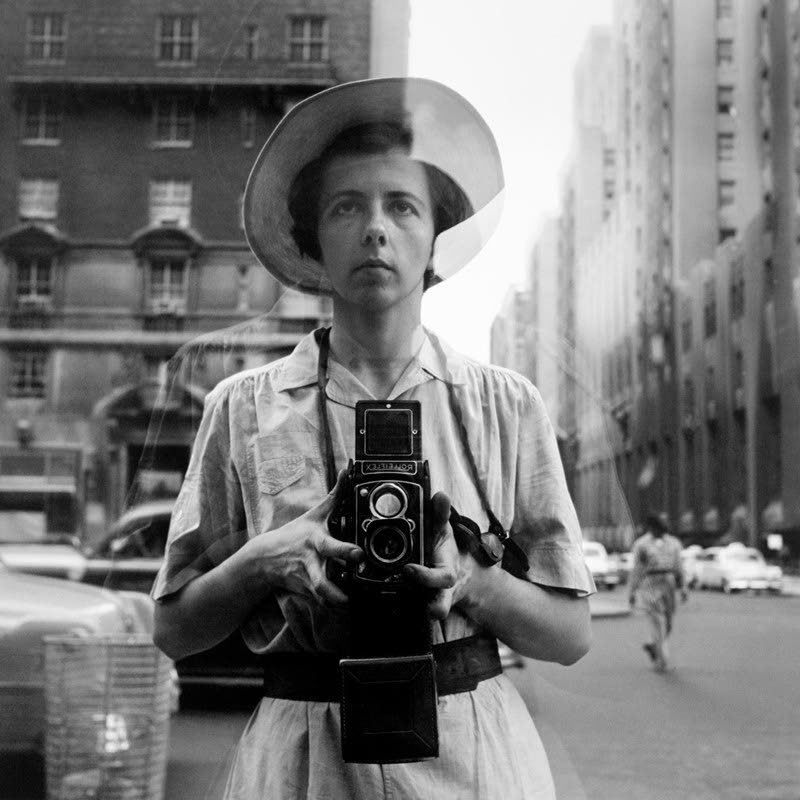Vivian Maier’s street photography

It was with great fascination and excitement that I finally settled down to look at the documentary Finding Vivian Maier.
For those who take photographs, but who don’t necessarily follow the movement, Vivian Maier came into the light in 2007 when a realtor John Maloof bought what turned out to be about 30,000 photo negatives taken by the photographer. Vivian Maier, as the story goes, worked as a nanny, her camera going wherever she went. She was an obsessive observer and street photographer who died penniless and unknown. She left behind over 100,000 negatives and thousands of rolls of undeveloped film. Maloof, recognising the genius of the work, made it his mission to search out, at his own expense, her archive of work and people who knew her in the drive to bring her name out into the public and in the world of art.
The photographs we get a glimpse of in the documentary, show a woman at home in the world. There is seriousness and a playfulness to her work. She observes others as they observe her. The large number of self-portraits also tell us of a woman observing herself. She was unmarried, a personality that vacillated between polite and pleasant to mean and scary – according to some of the children, now grown adults, recalling their interaction with her. Intensely private, there is no evidence of her showing her work to anyone. Wherever she worked, she insisted that her bedroom door be fitted with a lock to which only she had the key. She wore clothes that people described as outdated, "like a man’s," not fashionable. She seemed to have had her own style, walked her own path, lived true to herself. There is also a tragic element in her story. A lone woman, sitting on a park bench in her old age. This was a last memory of her. And then people heard she had died in 2009.
Born in 1926, Vivian Maier covered through her photographs, mainly the many lives of Chicago. They capture, as most street photography does, the changes in landscape – people and architecture, seasons and work. They provide an insight into the layered life of the city. But this is also a woman’s eye – a woman who chose to be a nanny, who enjoyed her job, who had no connections in the art world, who seemed fuelled by the urge to photograph yet never seemed to have wanted to do it as a living. Perhaps in a sense, the task of caring for others was an act of self-preservation too. Around children, one maintains a sense of play. These little beings are usually non-judgemental, people around whom a mask is not necessary. One can only assume this to be one of the motivations for her chosen profession which she reputedly did for 40 years.
She was a loner, a trait that is slightly more acceptable in a woman nowadays, yet still enigmatic. She travelled the world alone, had no family that anyone knows of, no romantic interests, no one to call her own. There are obsessions too – her anger at and fear of men, her aloofness, her obsession with newspapers, which she hoarded. Yet her portraits, taken at close range reflect a personality that could get into people’s personal spaces, someone who also seemed to be welcomed. The photographs tell the story of a photographer who is not contriving a scene, but looking at the world with eyes that were empathetic and truthful.
Most stories told are those of artists who knew that they wanted to be artists, people who fit into a particular school of thought. Vivian Maier is different. She remained a shadow character, one who held her camera not necessarily to her eye but at her hip as people recall.
Despite the evidently brilliant work, and particularly the fact that Maier’s work fits into a time when street photography was gaining momentum, Maloof’s difficulty was getting galleries to accept the work. They were not open to showcasing the work of an individual who was unknown, whose work they could not fit into a particular canon.
This brings us to the essential question: if some artists are really that great, then why is it that so many have died penniless, their work only gaining fame after their deaths? Who determines their greatness and how is that greatness qualified?
Maier’s story and the early challenges of getting her work recognised is a perfect example of how we label things, how the market conditions the way we view success and how we, as individuals and societies, qualify success. And if the story highlights one point, it is that there is a need to re-frame the way in which we quantify and qualify success, if we are to create healthy futures.



Comments
"Vivian Maier’s street photography"